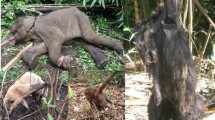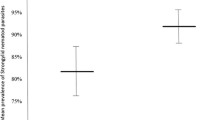Abstract
Snare injuries to chimpanzees (Pan troglodytes) have been reported at many study sites across Africa, and in some cases cause the death of the ensnared animal. However, very few snare injuries have been reported concerning the chimpanzees of Bossou, Guinea. The rarity of snare injuries in this study group warrants further consideration, given the exceptionally close proximity of the Bossou chimpanzees to human settlements and the widespread practice of snare hunting in the area. Herein we report a total of six observations of chimpanzees attempting to break and deactivate snares, successfully doing so on two of these occasions. We observed the behavior in 5 males, ranging in age from juveniles to adults. We argue that such active responses to snares must be contributing to the rarity of injuries in this group. Based on our observations, we suggest that the behavior has transmitted down the group. Our research team at Bossou continues to remove snares from the forest, but the threat of ensnarement still remains. We discuss potential ways to achieve a good balance between human subsistence activities and the conservation of chimpanzees at Bossou, which will increasingly be an area of great concern in the future.


Similar content being viewed by others
References
Amiti S, Babweteera F, Wittig RM (2008) Snare removal by a chimpanzee of the Sonso community, Budongo Forest (Uganda). Pan Afr News 15:6–8
Biro D, Sousa C, Matsuzawa T (2006) Ontogeny and cultural propagation of tool use by wild chimpanzees at Bossou, Guinea: case studies in nut cracking and leaf folding. In: Matsuzawa T, Tomonaga M, Tanaka M (eds) Cognitive development in chimpanzees. Springer, Tokyo, pp 476–508
Boesch C, Boesch-Achermann H (2000) The chimpanzees of the Taï forest. Oxford University Press, New York
Byrne RW, Stokes EJ (2002) Effects of manual disability on feeding skills in gorillas and chimpanzees. Int J Primatol 23:539–554
Hashimoto C (1999) Snare injuries of chimpanzees in the Kalinzu Forest, Uganda. Pan Afr News 6:20–22
Hashimoto C, Cox D, Furuichi T (2007) Snare removal for conservation of chimpanzees in the Kalinzu Forest Reserve, Uganda. Pan Afr News 14:8–11
Hockings KJ, Anderson JR, Matsuzawa T (2006) Road crossing in chimpanzees: a risky business. Curr Biol 16:R668–R670
Matsuzawa T (1994) Field experiments on use of stone tools in the wild. In: Wrangham RW, McGrew WC, de Waal FBM, Heltne P (eds) Chimpanzee cultures. Harvard University Press, Cambridge, pp 351–370
Pusey AE, Pintea L, Wilson ML, Kamenya S, Goodall J (2007) The contribution of long-term research at Gombe National Park to chimpanzee conservation. Conserv Biol 21:623–634
Quiatt D, Reynolds V, Stokes EJ (2002) Snare injuries to chimpanzees (Pan troglodytes) at 10 study sites in east and west Africa. Afr J Ecol 40:303–305
Reynolds V (2005) The chimpanzees of the Budongo Forest. Oxford University Press, New York
Sato H (1983) Hunting of the Boyela, slash-and-burn agriculturalists, in the central Zaire forest. Afr Study Monogr 4:1–54
Stokes EJ, Byrne RW (2001) Cognitive capacities for behavioural flexibility in wild chimpanzees (Pan troglodytes): the effect of snare injury on complex manual food processing. Anim Cogn 4:11–28
Sugiyama Y, Koman J (1979) Social structure and dynamics of wild chimpanzees at Bossou, Guinea. Primates 20:323–339
Waller JC, Reynolds V (2001) Limb injuries resulting from snares and traps in chimpanzees (Pan troglodytes schweinfurthii) of the Budongo forest, Uganda. Primates 42:135–139
Whiten A, Goodall J, McGrew WC, Nishida T, Reynolds V, Sugiyama Y, Tutin CEG, Wrangham RW, Boesch C (1999) Culture in chimpanzees. Nature 399:682–685
Yamakoshi G, Takemoto H, Matsuzawa T, Sugiyama Y (1999) Research history and conservation status of chimpanzees at Bossou, Guinea. Primate Res 15:101–114 (in Japanese with English summary)
Acknowledgments
We are grateful to the Direction Nationale de la Recherche Scientifique et Technique, and Institut Recherche Environnementale de Bossou in Guinea for permission to carry out this research. P. Goumy, J. Dore, H.D. Camara, P. Cherif, B. Zogbira, and M. Dore provided helpful field assistance at Bossou. We thank Professor Y. Sugiyama, Dr. G. Yamakoshi, and anonymous colleagues for their support at the study site. A. MacIntosh helped to improve the manuscript. We thank an anonymous reviewer for helpful comments on the manuscript. This study was financed by grants of the Ministry of Education, Culture, Sports, Science, and Technology, Japan (nos. 12002009, 16002001, and 20002001 to T. Matsuzawa), a grant under Research Fellowships of the JSPS for Young Scientists (no. 160896 to G. Ohashi), and a grant of JSPS AA Science Platform Program to T. Furuichi.
Author information
Authors and Affiliations
Corresponding author
About this article
Cite this article
Ohashi, G., Matsuzawa, T. Deactivation of snares by wild chimpanzees. Primates 52, 1–5 (2011). https://doi.org/10.1007/s10329-010-0212-8
Received:
Accepted:
Published:
Issue Date:
DOI: https://doi.org/10.1007/s10329-010-0212-8




